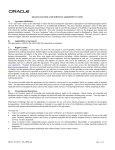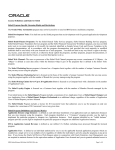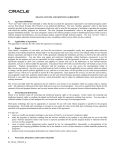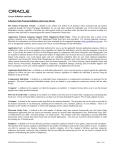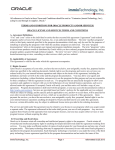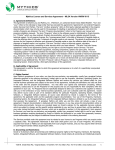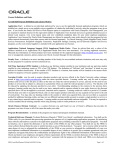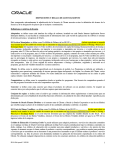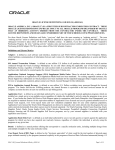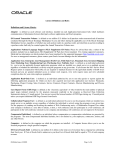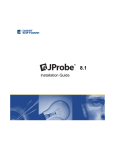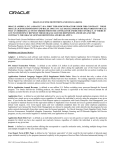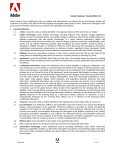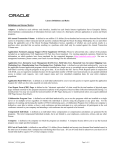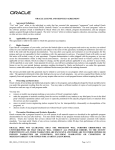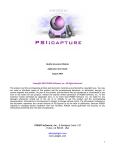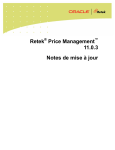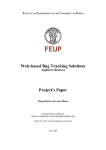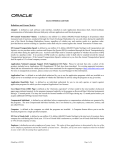Download OLSA_V020409_US.doc Page 1 of 18 ORACLE LICENSE AND
Transcript
ORACLE LICENSE AND SERVICES AGREEMENT A. Agreement Definitions “You” and “your” refers to the individual or entity that has executed this agreement (“agreement”) and ordered programs and/or services from Oracle USA, Inc. (“Oracle”) or an authorized distributor. The term “ancillary programs” refers to third party materials specified in the program documentation which may only be used for the purposes of installing or operating the programs with which the ancillary programs are delivered. The term “program documentation” refers to the program user manual and program installation manuals. The term “programs” refers to the software products owned or distributed by Oracle which you have ordered, program documentation, and any program updates acquired through technical support. The term “services” refers to technical support, education, hosted/outsourcing services, consulting or other services which you have ordered. B. Applicability of Agreement This agreement is valid for the order which this agreement accompanies. C. Rights Granted Upon Oracle’s acceptance of your order, you have the non-exclusive, non-assignable, royalty free, perpetual (unless otherwise specified in the ordering document), limited right to use the programs and receive any services you ordered solely for your internal business operations and subject to the terms of this agreement, including the definitions and rules set forth in the order and the program documentation. You may allow your agents and contractors (including, without limitation, outsourcers) to use the programs for this purpose and you are responsible for their compliance with this agreement in such use. For programs that are specifically designed to allow your customers and suppliers to interact with you in the furtherance of your internal business operations, such use is allowed under this agreement. If accepted, Oracle will notify you and this notice will include a copy of your agreement. Program documentation is delivered with the programs, or you may access the documentation online at http://oracle.com/contracts. Services are provided based on Oracle’s policies for the applicable services ordered, which are subject to change, and the specific policies applicable to you, and how to access them, will be specified on your order (except technical support services, which are as specified in section H of this agreement). Upon payment for services, you have the nonexclusive, non-assignable, royalty free, perpetual, limited right to use for your internal business operations anything developed by Oracle and delivered to you under this agreement; however, certain deliverables may be subject to additional license terms provided in the ordering document. The services provided under this agreement may be related to your license to use programs which you acquire under a separate order. The agreement referenced in that order shall govern your use of such programs. Any services acquired from Oracle are bid separately from such program licenses, and you may acquire either services or such program licenses without acquiring the other. D. Ownership and Restrictions Oracle or its licensors retain all ownership and intellectual property rights to the programs. Oracle retains all ownership and intellectual property rights to anything developed by Oracle and delivered to you under this agreement resulting from the services. You may make a sufficient number of copies of each program for your licensed use and one copy of each program media. Third party technology that may be appropriate or necessary for use with some Oracle programs is specified in the program documentation. Such third party technology is licensed to you under the terms of the third party technology license agreement specified in the program documentation and not under the terms of this agreement. You may not: • remove or modify any program markings or any notice of Oracle’s or its licensors’ proprietary rights; • make the programs or materials resulting from the services available in any manner to any third party for use in the third party’s business operations (unless such access is expressly permitted for the specific program license or materials from the services you have acquired); • cause or permit reverse engineering (unless required by law for interoperability), disassembly or decompilation of the programs (the foregoing prohibition includes but is not limited to review of data structures or similar materials produced by programs); • disclose results of any program benchmark tests without Oracle’s prior written consent. E. Warranties, Disclaimers and Exclusive Remedies OLSA_V020409_US.doc Page 1 of 18 Oracle warrants that a program licensed to you will operate in all material respects as described in the applicable program documentation for one year after delivery (i.e., via physical shipment or electronic download). You must notify Oracle of any program warranty deficiency within one year after delivery. Oracle also warrants that services will be provided in a professional manner consistent with industry standards. You must notify Oracle of any services warranty deficiencies within 90 days from performance of the defective services. ORACLE DOES NOT GUARANTEE THAT THE PROGRAMS WILL PERFORM UNINTERRUPTED OR THAT ORACLE WILL CORRECT ALL PROGRAM ERRORS. ERROR-FREE OR FOR ANY BREACH OF THE ABOVE WARRANTIES, YOUR EXCLUSIVE REMEDY AND ORACLE’S ENTIRE LIABILITY SHALL BE: (A) THE CORRECTION OF PROGRAM ERRORS THAT CAUSE BREACH OF THE WARRANTY; OR, IF ORACLE CANNOT SUBSTANTIALLY CORRECT SUCH BREACH IN A COMMERCIALLY REASONABLE MANNER, YOU MAY END YOUR PROGRAM LICENSE AND RECOVER THE FEES PAID TO ORACLE FOR THE PROGRAM LICENSE AND ANY UNUSED, PREPAID TECHNICAL SUPPORT FEES YOU HAVE PAID FOR THE PROGRAM LICENSE; OR (B) THE REPERFORMANCE OF THE DEFICIENT SERVICES; OR, IF ORACLE CANNOT SUBSTANTIALLY CORRECT A BREACH IN A COMMERCIALLY REASONABLE MANNER, YOU MAY END THE RELEVANT SERVICES AND RECOVER THE FEES PAID TO ORACLE FOR THE DEFICIENT SERVICES. TO THE EXTENT PERMITTED BY LAW, THESE WARRANTIES ARE EXCLUSIVE AND THERE ARE NO OTHER EXPRESS OR IMPLIED WARRANTIES OR CONDITIONS INCLUDING WARRANTIES OR CONDITIONS OF MERCHANTABILITY AND FITNESS FOR A PARTICULAR PURPOSE. F. Trial Programs You may order trial programs, or Oracle may include additional programs with your order which you may use for trial, nonproduction purposes only. You may not use the trial programs to provide or attend third party training on the content and/or functionality of the programs. You have 30 days from the delivery date to evaluate these programs. If you decide to use any of these programs after the 30 day trial period, you must obtain a license for such programs from Oracle or an authorized distributor. If you decide not to obtain a license for any program after the 30 day trial period, you will cease using and will delete any such programs from your computer systems. Programs licensed for trial purposes are provided “as is” and Oracle does not provide technical support or offer any warranties for these programs. G. Indemnification If a third party makes a claim against either you or Oracle (“Recipient” which may refer to you or Oracle depending upon which party received the Material), that any information, design, specification, instruction, software, data, or material (“Material”) furnished by either you or Oracle (“Provider” which may refer to you or Oracle depending on which party provided the Material), and used by the Recipient infringes its intellectual property rights, the Provider, at its sole cost and expense, will defend the Recipient against the claim and indemnify the Recipient from the damages, liabilities, costs and expenses awarded by the court to the third party claiming infringement or the settlement agreed to by the Provider, if the Recipient does the following: • • • notifies the Provider promptly in writing, not later than 30 days after the Recipient receives notice of the claim (or sooner if required by applicable law); gives the Provider sole control of the defense and any settlement negotiations; and gives the Provider the information, authority, and assistance the Provider needs to defend against or settle the claim. If the Provider believes or it is determined that any of the Material may have violated a third party’s intellectual property rights, the Provider may choose to either modify the Material to be non-infringing (while substantially preserving its utility or functionality) or obtain a license to allow for continued use, or if these alternatives are not commercially reasonable, the Provider may end the license for, and require return of, the applicable Material and refund any fees the Recipient may have paid for it and any unused, prepaid technical support fees you have paid for the license. If you are the Provider and such return materially affects Oracle’s ability to meet its obligations under the relevant order, then Oracle may, at its option and upon 30 days prior written notice, terminate the order. The Provider will not indemnify the Recipient if the Recipient alters the Material or uses it outside the scope of use identified in the Provider’s user documentation or if the Recipient uses a version of the Materials which has been superseded, if the infringement claim could have been avoided by using an unaltered current version of the Material which was provided to the Recipient. The Provider will not indemnify the Recipient to the extent that an infringement claim is based upon any information, design, specification, instruction, software, data, or material not furnished by the Provider. Oracle will not indemnify you to the extent that an infringement claim is based upon the combination of any Material with any products or services not provided by Oracle. Oracle will not indemnify you for infringement caused by your actions against any third party if OLSA_V020409_US.doc Page 2 of 18 the Oracle program(s) as delivered to you and used in accordance with the terms of this agreement would not otherwise infringe any third party intellectual property rights. This section provides the parties’ exclusive remedy for any infringement claims or damages. H. Technical Support For purposes of the ordering document, technical support consists of annual technical support services you may have ordered for the programs. If ordered, annual technical support (including first year and all subsequent years) is provided under Oracle’s technical support policies in effect at the time the services are provided. The technical support policies, incorporated in this agreement, are subject to change at Oracle’s discretion; however, Oracle will not materially reduce the level of services provided for supported programs during the period for which fees for technical support have been paid. You should review the policies prior to entering into the ordering document for the applicable services. You may access the current version of the technical support policies at http://oracle.com/contracts. Technical support is effective upon the effective date of the ordering document unless otherwise stated in your order. If your order was placed through the Oracle Store, the effective date is the date your order was accepted by Oracle. Software Update License & Support (or any successor technical support offering to Software Update License & Support, “SULS”) acquired with your order may be renewed annually and, if you renew SULS for the same number of licenses for the same programs, for the first and second renewal years the fee for SULS, will not increase by more than 5% over the prior year’s fees. If your order is fulfilled by a member of Oracle’s partner program, the fee for SULS for the first renewal year will be the price quoted to you by your partner; the fee for SULS for the second renewal year will not increase by more than 5% over the prior year's fees. If you decide to purchase technical support for any license within a license set, you are required to purchase technical support at the same level for all licenses within that license set. You may desupport a subset of licenses in a license set only if you agree to terminate that subset of licenses. The technical support fees for the remaining licenses will be priced in accordance with the technical support policies in effect at the time of termination. Oracle’s license set definition is available in the current technical support policies. If you decide not to purchase technical support, you may not update any unsupported program licenses with new versions of the program. I. End of Agreement If either of us breaches a material term of this agreement and fails to correct the breach within 30 days of written specification of the breach, then the breaching party is in default and the non-breaching party may terminate this agreement. If Oracle ends this agreement as specified in the preceding sentence, you must pay within 30 days all amounts which have accrued prior to such end, as well as all sums remaining unpaid for programs ordered and/or services received under this agreement plus related taxes and expenses. If Oracle ends the license for a program under the Indemnification section, you must pay within 30 days all amounts remaining unpaid for services related to such license plus related taxes and expenses. Except for nonpayment of fees, the nonbreaching party may agree in its sole discretion to extend the 30 day period for so long as the breaching party continues reasonable efforts to cure the breach. You agree that if you are in default under this agreement, you may not use those programs and/or services ordered. You further agree that if you have used an Oracle Financing Division contract to pay for the fees due under an order and you are in default under that contract, you may not use the programs and/or services that are subject to such contract. Provisions that survive termination or expiration are those relating to limitation of liability, infringement indemnity, payment, and others which by their nature are intended to survive. J. Fees and Taxes All fees payable to Oracle are due within 30 days from the invoice date. You agree to pay any sales, value-added or other similar taxes imposed by applicable law that Oracle must pay based on the programs and/or services you ordered, except for taxes based on Oracle’s income. Also, you will reimburse Oracle for reasonable expenses related to providing the services. Fees for services listed in an ordering document are exclusive of taxes and expenses. You agree that you have not relied on the future availability of any programs or updates in entering into the payment obligations in your ordering document; however, (a) if you order SULS for programs, the preceding sentence does not relieve Oracle of its obligation to provide updates under your ordering document, if-and-when available, in accordance with Oracle’s then current technical support policies, and (b) the preceding sentence does not change the rights granted to you for any program licensed under your ordering document, per the terms of your ordering document and this agreement. K. Nondisclosure By virtue of this agreement, the parties may have access to information that is confidential to one another (“confidential information”). We each agree to disclose only information that is required for the performance of obligations under this OLSA_V020409_US.doc Page 3 of 18 agreement. Confidential information shall be limited to the terms and pricing under this agreement and all information clearly identified as confidential at the time of disclosure. A party’s confidential information shall not include information that: (a) is or becomes a part of the public domain through no act or omission of the other party; (b) was in the other party’s lawful possession prior to the disclosure and had not been obtained by the other party either directly or indirectly from the disclosing party; (c) is lawfully disclosed to the other party by a third party without restriction on the disclosure; or (d) is independently developed by the other party. We each agree to hold each other’s confidential information in confidence for a period of three years from the date of disclosure. Also, we each agree to disclose confidential information only to those employees or agents who are required to protect it against unauthorized disclosure. Nothing shall prevent either party from disclosing the terms or pricing under this agreement or orders submitted under this agreement in any legal proceeding arising from or in connection with this agreement or disclosing the confidential information to a federal or state governmental entity as required by law. L. Entire Agreement You agree that this agreement and the information which is incorporated into this agreement by written reference (including reference to information contained in a URL or referenced policy), together with the applicable ordering document, are the complete agreement for the programs and/or services ordered by you, and that this agreement supersedes all prior or contemporaneous agreements or representations, written or oral, regarding such programs and/or services. If any term of this agreement is found to be invalid or unenforceable, the remaining provisions will remain effective and such term shall be replaced with a term consistent with the purpose and intent of this agreement. It is expressly agreed that the terms of this agreement and any Oracle ordering document shall supersede the terms in any purchase order or other non-Oracle ordering document and no terms included in any such purchase order or other non-Oracle ordering document shall apply to the programs and/or services ordered. This agreement and ordering documents may not be modified and the rights and restrictions may not be altered or waived except in a writing signed or accepted online through the Oracle Store by authorized representatives of you and of Oracle. Any notice required under this agreement shall be provided to the other party in writing. M. Limitation of Liability NEITHER PARTY SHALL BE LIABLE FOR ANY INDIRECT, INCIDENTAL, SPECIAL, PUNITIVE, OR CONSEQUENTIAL DAMAGES, OR ANY LOSS OF PROFITS, REVENUE, DATA, OR DATA USE. ORACLE’S MAXIMUM LIABILITY FOR ANY DAMAGES ARISING OUT OF OR RELATED TO THIS AGREEMENT OR YOUR ORDER, WHETHER IN CONTRACT OR TORT, OR OTHERWISE, SHALL BE LIMITED TO THE AMOUNT OF THE FEES YOU PAID ORACLE UNDER THIS AGREEMENT, AND IF SUCH DAMAGES RESULT FROM YOUR USE OF PROGRAMS OR SERVICES, SUCH LIABILITY SHALL BE LIMITED TO THE FEES YOU PAID ORACLE FOR THE DEFICIENT PROGRAM OR SERVICES GIVING RISE TO THE LIABILITY. N. Export Export laws and regulations of the United States and any other relevant local export laws and regulations apply to the programs. You agree that such export control laws govern your use of the programs (including technical data) and any services deliverables provided under this agreement, and you agree to comply with all such export laws and regulations (including “deemed export” and “deemed re-export” regulations). You agree that no data, information, program and/or materials resulting from services (or direct product thereof) will be exported, directly or indirectly, in violation of these laws, or will be used for any purpose prohibited by these laws including, without limitation, nuclear, chemical, or biological weapons proliferation, or development of missile technology. O. Other 1. This agreement is governed by the substantive and procedural laws of California and you and Oracle agree to submit to the exclusive jurisdiction of, and venue in, the courts in San Francisco, San Mateo, or Santa Clara counties in California in any dispute arising out of or relating to this agreement. 2. If you have a dispute with Oracle or if you wish to provide a notice under the Indemnification section of this agreement, or if you become subject to insolvency or other similar legal proceedings, you will promptly send written notice to: Oracle USA, Inc., 500 Oracle Parkway, Redwood City, California, USA, Attention: General Counsel, Legal Department. 3. You may not assign this agreement or give or transfer the programs and/or any services or an interest in them to another individual or entity. If you grant a security interest in the programs and/or any services deliverables, the secured party has no right to use or transfer the programs and/or any services deliverables, and if you decide to finance your acquisition of the programs and/or any services, you will follow Oracle’s policies regarding financing which are at http://oracle.com/contracts. OLSA_V020409_US.doc Page 4 of 18 4. Except for actions for nonpayment or breach of Oracle’s proprietary rights, no action, regardless of form, arising out of or relating to this agreement may be brought by either party more than two years after the cause of action has accrued. 5. Upon 45 days written notice, Oracle may audit your use of the programs. You agree to cooperate with Oracle’s audit and provide reasonable assistance and access to information. Any such audit shall not unreasonably interfere with your normal business operations. You agree to pay within 30 days of written notification any fees applicable to your use of the programs in excess of your license rights. If you do not pay, Oracle can end your technical support, licenses and/or this agreement. You agree that Oracle shall not be responsible for any of your costs incurred in cooperating with the audit. 6. The Uniform Computer Information Transactions Act does not apply to this agreement or orders placed under it. You understand that Oracle’s business partners, including any third party firms retained by you to provide computer consulting services, are independent of Oracle and are not Oracle’s agents. Oracle is not liable for nor bound by any acts of any such business partner, unless the business partner is providing services as an Oracle subcontractor on an engagement ordered under this agreement. P. Force Majeure Neither of us shall be responsible for failure or delay of performance if caused by: an act of war, hostility, or sabotage; act of God; electrical, internet, or telecommunication outage that is not caused by the obligated party; government restrictions (including the denial or cancellation of any export or other license); other event outside the reasonable control of the obligated party. We both will use reasonable efforts to mitigate the effect of a force majeure event. If such event continues for more than 90 days, either of us may cancel unperformed services upon written notice. This section does not excuse either party’s obligation to take reasonable steps to follow its normal disaster recovery procedures or your obligation to pay for programs delivered or services provided. Q. License Definitions and Rules To fully understand your license grant, you need to review the definition for the licensing metric and term designation as well as the licensing rules which are incorporated in and made a part of this agreement. Definitions and License Metrics Adapter: is defined as each software code interface, installed on each Oracle Internet Application Server Enterprise Edition, which facilitates communication of information between each version of a third party software application or system and Oracle Programs. $M Annual Transaction Volume: is defined as one million U.S. dollars ($1,000,000) in all purchase orders transacted and all auctions conducted through the Oracle Exchange Marketplace by you and others during the applicable year of the Oracle Exchange Marketplace license, regardless of whether any such auction results in a purchase order, provided that an auction resulting in a purchase order shall only be counted against the Annual Transaction Volume once. Applications National Language Support (NLS) Supplement Media Packs: Please be advised that only a subset of the products included on an Applications NLS Supplement Media Pack have been translated. For existing supported customers, MetaLink has information on which products have been translated for the supported languages (http://metalink.oracle.com). For new or unsupported customers, please contact your Oracle Account Manager for this information. Application User: is defined as an individual authorized by you to use the applicable licensed application programs which are installed on a single server or on multiple servers regardless of whether the individual is actively using the programs at any given time. If you license the Oracle Self Service Work Request option in conjunction with Oracle Enterprise Asset Management, you are required to maintain licenses for the equivalent number of Application Users licensed and you are granted unlimited access to initiate work requests, view work request status and view scheduled completion dates for your entire employee population. Application Users licensed for Oracle Order Management are allowed to manually enter orders directly into the programs but any orders entered electronically from other sources must be licensed separately. For Oracle Sourcing, Oracle iSupplier Portal, Oracle Services Procurement, PeopleSoft eSupplier Connection and PeopleSoft Strategic Sourcing programs, use by your external suppliers is included with your application user licenses. Application Read-Only User: is defined as an individual authorized by you to run only queries or reports against the application program for which you have also acquired non read-only licenses. Case Report Form (CRF) Page: is defined as the "electronic equivalent" of what would be the total number of physical paper OLSA_V020409_US.doc Page 5 of 18 pages initiated remotely by the program (measured explicitly in the program as Received Data Collection Instruments) during a 12 month period. You may not exceed the licensed number of CRF Pages during any 12 month period unless you acquire additional CRF Page licenses from Oracle. Client Machine: is defined as the computer from which the programs are being accessed, regardless of where the program is installed. Collaboration Program User: is defined as an individual authorized by you to use the programs which are installed on a single server or on multiple servers regardless of whether the individual is actively using the programs at any given time. For the purposes of counting and licensing the number of Real Time Collaboration users, a Collaboration Program User within your company is defined as a user able to initiate, or host, a web conference and also participate in a web conference; all participants in the web conference external to your company and attending a web conference are not required to be licensed. Compensated Individual: is defined as an individual whose compensation or compensation calculations are generated by the programs. The term Compensated Individual includes, but is not limited to, your employees, contractors, retirees, and any other Person. Computer: is defined as the computer on which the programs are installed. A Computer license allows you to use the licensed program on a single specified computer. Concurrent User: is defined as the maximum number of users accessing at any one time. Connector: is defined as each connector connecting the software product with an external product. A unique connector is required for each distinct product that the software product is required to interface. $M Cost of Goods Sold: is defined as one million U.S. dollars ($1,000,000) in the total cost of inventory that a company has sold during their fiscal year. If Cost of Goods Sold is unknown to you then Cost of Goods Sold shall be equal to 75% of total company revenue. CPU: is defined as a processor upon which a program is installed and/or running. For the purposes of counting the number of CPUs which require licensing for a multi-core processor, each additional core above the first two cores shall count as .25 CPUs. All fractions of a number are to be rounded up to the next whole number. This definition only applies to those programs with “BEA” in the program name. Custom Suite User: is defined as an individual authorized by you to use the application programs included in the applicable Custom Applications Suite which are installed on a single server or on multiple servers regardless of whether the individual is actively using the programs at any given time. Customer: is defined as the customer entity specified on the ordering document. The programs may not be used or accessed for the business operations of any third party, including but not limited to your customers, partners, or your affiliates. There is no limitation on the number of computers on which such programs may be copied, installed and used. Developer Kit: is defined as a single copy of the distributed program. Developer User / Developer/ Developer Seat: is defined as an individual authorized by you to use the programs which are installed on a single server or multiple servers, regardless of whether the individual is actively using the programs at any given time. With respect to Developer Users only, such users may create, modify, view and interact with the programs and documentation. Electronic Order Line: is defined as the total number of distinct order lines entered electronically into the Oracle Order Management application from any source (not manually entered by licensed Order Management Users, Professional Users 2003, or Professional Users 2003 - External) during a 12 month period. This includes order lines originating as external EDI/XML transactions and/or sourced from other Oracle and non-Oracle applications. You may not exceed the licensed number of order lines during any 12 month period. Employee: is defined as all of your full-time, part-time, temporary employees and all of your agents, contractors and consultants. The quantity of the licenses required is determined by the number of Employees and not the actual number of users. In addition, if you elect to outsource any business function(s) to another company, all of the company's full-time, part-time, temporary OLSA_V020409_US.doc Page 6 of 18 employees and agents, contractors and consultants that are providing the outsourcing services for you must be counted for the purposes of determining the number of Employees. Employee User: is defined as an individual authorized by you to use the programs which are installed on a single server or multiple servers, regardless of whether or not the individual is actively using the programs at any given time Expense Report: is defined as the total number of expense reports processed by Internet Expenses during a 12 month period. You may not exceed the licensed number of expense reports during any 12 month period. Faculty User: is defined as an active teaching member of the faculty for an accredited academic institution; such user may only use the programs for academic and non-commercial use. Field Technician: is defined as an engineer, technician, representative, or other person who is dispatched by you, including the dispatchers, to the field using the programs. $M Freight Under Management: is defined as one million US Dollars ($1,000,000) of the total transportation value of tendered orders for all shipments for a given calendar year during the term of the license. FUM shall include the combined total of actual freight purchased by you, plus the cost of freight for shipments managed by you (e.g., you are not purchasing transportation services on behalf of your clients but are providing transportation management services for your clients). Freight that is paid by a third party shall also be included in the FUM total (e.g., inbound shipments from suppliers to you with freight terms of prepaid). Full Time Equivalent (FTE) Student: is defined as any full-time student enrolled in your institution and any part-time student enrolled in your institution counts as 25% of an FTE Student. The definition of "full-time" and "part-time" is based on your policies for student classification. If the number of FTE Students is a fraction, that number will be rounded to the nearest whole number for purposes of license quantity requirements. Hosted Named User: is defined as an individual authorized by you to access the hosted service, regardless of whether the individual is actively accessing the hosted service at any given time. Instance: is defined as a single installation of the program that you may install and run on one computer. For purposes of this definition a JVM is defined as a Java Virtual Machine. For purposes of WebLogic Server Virtual Edition, an instance is defined as 1 WebLogic Server Virtual Edition node running in 1 LiquidVM (= 1 JVM + 1 virtual machine). A customer is required to license and pay for the maximum number of simultaneous instances they will deploy. A WebLogic Server Virtual Edition node is a copy of BEA’s WebLogic Server integrated and packaged with BEA’s LiquidVM so as to run as a software appliance within a dedicated virtual machine without requiring the need to install or configure any other software within that virtual machine. A LiquidVM is an integration of the BEA JRockit JVM with boot layer that allows the BEA JRockit JVM to run as a single dedicated process within the hypervisor-based virtual machine without requiring any 3rd party operating system. For purposes of AquaLogic Enterprise Repository (ALER) products, an instance is defined as a single installation of the ALER product on one computer. For purposes of WebLogic Operations Control, an instance is defined as a single WebLogic Operations Control server node running in a single JVM, irrespective of the number of CPUs, servers or similar used metrics to run the software. For purposes of WebLogic Operations Control Smart Packs, an instance is defined as a single WebLogic Operations Control server node running in a single JVM enabled with the functionality of the Smart Pack. For purposes of WebLogic Operations Control Managed Instance (WLOC), an instance is defined as the target application under management of WLOC running within a single JVM or as an instance of Virtual Edition versions of BEA products. For purposes of WebLogic Operations Control LiquidVM Container, an instance is defined as a single LiquidVM node running in a single virtual machine, irrespective of the number of CPUs, servers or similar used metrics to run the software. 1K Invoice Line: is defined as one thousand invoice line items processed by the program during a 12 month period. You may not exceed the licensed number of Invoice Lines during any 12 month period unless you acquire additional Invoice Line licenses from Oracle. OLSA_V020409_US.doc Page 7 of 18 IVR Port: is defined as a single caller that can be processed via the Interactive Voice Response (IVR) system. You must purchase licenses for the number of IVR Ports that represent the maximum number of concurrent callers that can be processed by the IVR system. Learning Credits: may be used to acquire education products and services offered in the Oracle University online catalogue posted at http://www.oracle.com/education under the terms specified therein. Learning credits may only be used to acquire products and services at the list price in effect at the time you order the relevant product or service, and may not be used for any product or service that is subject to a discount or a promotion when you order the relevant product or service. The list price will be reduced by applying the discount specified in your order. Notwithstanding anything to the contrary in the previous three sentences, learning credits may also be used to pay taxes, materials and/or expenses related to your order; however, the discount specified above will not be applied to such taxes, materials and/or expenses. Learning credits are valid for a period of 12 months from the date your order is accepted by Oracle, and you must acquire products and must use any acquired services prior to the end of such period. You may only use learning credits in the country in which you acquired them, may not use them as a payment method for additional learning credits, and may not use different learning credits accounts to acquire a single product or service or to pay related taxes, materials and/or expenses. Learning credits are non-transferable and non-assignable. You may be required to execute standard Oracle ordering materials when using learning credits to order products or services. $M in Managed Assets: is defined as one million U.S. dollars ($1,000,000) of the following total: (1) Book value of investment in capital leases, direct financing leases and other finance leases, including residuals, whether owned or managed for others, active on the program, plus (2) Book value of assets on operating leases, whether owned or managed for others, active on the program, plus (3) Book value of loans, notes, conditional sales contracts and other receivables, owned or managed for others, active on the program, plus (4) Book value of non earning assets, owned or managed for others, which were previously leased and active on the program, including assets from term terminated leases and repossessed assets, plus (5) Original cost of assets underlying leases and loans, originated and active on the program, then sold within the previous 12 months. Membership: is defined as an individual authorized by you to access the hosted service, regardless of whether the individual is accessing the hosted service at any given time. Module: is defined as each production database running the programs. Monitored User: is defined as an individual who is monitored by an Analytics program which is installed on a single server or multiple servers, regardless of whether the individual is actively being monitored at any given time. Individual users who are licensed for an Analytics program by either Named User Plus or Application User may not be licensed by Monitored User. For the purposes of the Usage Accelerator Analytics program, every user of your licensed CRM Sales application program must be licensed. For the purposes of the Human Resources Compensation Analytics program, all of your employees must be licensed. For the purpose of the following Oracle Governance, Risk, and Compliance applications: Application Access Controls Governor, Application Access Controls for E-Business Suite, Configuration Controls Governor, Configuration Controls for E-Business Suite, Transaction Controls Governor, Preventive Controls Governor, and Governance, Risk, and Compliance Controls Suite, the number of Monitored Users is equal to the total number of unique E-Business Suite users (individuals) being monitored by the program(s), as created/defined in the User Administration function of E-Business Suite. Users of iProcurement and/or SelfService Human Resources are excluded. For the purpose of the following PeopleSoft Enterprise Governance, Risk, and Compliance applications: Application Access Controls Governor, Application Access Controls for PeopleSoft Enterprise, Configuration Controls Governor, and Configuration Controls for PeopleSoft Enterprise, the number of Monitored Users is equal to the total number of unique PeopleSoft Enterprise (or any other custom applications / programs) users (individuals) that the program monitors. Named User Plus / Named User: is defined as an individual authorized by you to use the programs which are installed on a single server or multiple servers, regardless of whether the individual is actively using the programs at any given time. All of the remaining provisions of this definition apply only with respect to Named User Plus licenses, and not to Named User licenses. A non human operated device will be counted as a named user plus in addition to all individuals authorized to use the programs, if such devices can access the programs. If multiplexing hardware or software (e.g., a TP monitor or a web server product) is used, this number must be measured at the multiplexing front end. Automated batching of data from computer to computer is permitted. You are responsible for ensuring that the named user plus per processor minimums are maintained for the programs contained in the user minimum table in the licensing rules section; the minimums table provides for the minimum number of named users plus required and all actual users must be licensed. OLSA_V020409_US.doc Page 8 of 18 For the purposes of the following programs: Configuration Management Pack for Non-Oracle Systems, System Monitoring Plugin for Hosts, System Monitoring Plug-in for Non Oracle Databases, System Monitoring Plug-in for Non Oracle Middleware, Diagnostics Pack for Non-Oracle Middleware and Provisioning Pack, only the users of the third party program that is being managed/monitored are counted for the purpose of determining the number of Named User Plus licenses required. For the purposes of the following programs: Application Management Pack for Oracle E-Business Suite, Application Management Pack for Siebel, and Application Management Pack for PeopleSoft Enterprise, all users of the middleware and/or database software that support the respective application program are counted for the purpose of determining the number of Named User Plus licenses required. With respect to the following programs: Load Testing for Web Applications, Load Testing for Web Applications Developer Edition, Load Testing Accelerator for Web Services, and Load Testing Accelerator for Siebel, each emulated human user and non human operated device shall be considered as a virtual user and shall be counted when determining the number of Named User Plus licenses required. Network Device: is defined as the hardware and/or software whose primary purpose is to route and control communications between computers or computer networks. Examples of network devices include but are not limited to, routers, firewalls and network load balancers. Non-Concurrent User: is defined as an additional client device beyond the concurrent user count that can be enabled to access the program by the installation of BEA’s licensable client products. Non Employee User - External: is defined as an individual, who is not your employee, contractor or outsourcer, authorized by you to use the programs which are installed on a single server or multiple servers, regardless of whether or not the individual is actively using the programs at any given time. Oracle Finance Division Contract: is a contract between you and Oracle (or one of Oracle’s affiliates) that provides for payments over time of some or all of the sums due under your order. Oracle University Knowledge Center Service: is defined as a web based learning environment hosted by Oracle that provides on demand access to either an individual Oracle University training course (“Online Course”) or to all (or limited content subsets) of the Oracle University training courses available on the Knowledge Center website (“Passport”). The Oracle University Knowledge Center service is available at http://www.oracle.com/education/oukc/, and is made available to you subject to the terms of this agreement and Oracle University's Online Hosting Access Policies, which are located at http://www.oracle.com/education/oukc/hosting_policies.html and may be updated by Oracle from time to time without notice to you. Online Courses and Passports are made available on a membership basis. In the event that any Oracle programs are made available for download as part of the service, then use of such programs is subject to the terms of this agreement. If you acquire the Oracle University Knowledge Center service, the term shall be one year from the effective date of your order. NOTWITHSTANDING ANYTHING TO THE CONTRARY IN THE AGREEMENT, ORACLE DOES NOT WARRANT THAT THE ORACLE UNIVERSITY KNOWLEDGE CENTER SERVICE WILL BE PROVIDED UNINTERRUPTED OR ERROR-FREE. Order Line: is defined as the total number of order entry line items processed by the program during a 12 month period. Multiple order entry line items may be entered as part of an individual customer order or quote and may also be automatically generated by the Oracle Configurator. You may not exceed the licensed number of Order Lines during any 12 month period unless you acquire additional Order Line licenses from Oracle. Order Management User: is defined as an individual authorized by you to use the applicable licensed application programs which are installed on a single server or on multiple servers regardless of whether the individual is actively using the programs at any given time. Order Management Users are allowed to manually enter orders directly into the programs but any orders entered electronically from other sources must be licensed separately. Orders: is defined as the total number of distinct orders for all programs that are a part of Electronic Orders, entered electronically (not manually entered by licensed professional users) through EDI, XML or other electronic means including purchase orders transmitted from Oracle Purchasing, during a 12 month period. You may not exceed the licensed number of orders during any 12 month period. OLSA_V020409_US.doc Page 9 of 18 Partner Organization: is defined as an external third party business entity that provides value-added services in developing, marketing and selling your products. Depending upon the type of industry, partner organizations play different roles and are recognized by different names such as reseller, distributor, agent, dealer or broker. Person: is defined as your employee or contractor who is actively working on behalf of your organization or a former employee who has one or more benefit plans managed by the system or continues to be paid through the system. For Project Resource Management, a person is defined as an individual who is scheduled on a project. The total number of licenses needed is to be based on the peak number of part-time and full-time people whose records are recorded in the system. Physical Server: is defined as each physical server on which the programs are installed. Ported Number: is defined as the telephone number that end users retain as they change from one service provider to another. This telephone number originally resides on a telephone switch and is moved into the responsibility of another telephone switch. Processor: shall be defined as all processors where the Oracle programs are installed and/or running. Programs licensed on processor basis may be accessed by your internal users (including agents and contractors) and by your third party users. For the purposes of counting the number of processors which require licensing for a Sun UltraSPARC T1 processor with 4, 6 or 8 cores at 1.0 gigahertz or 8 cores at 1.2 gigahertz for only those servers specified on the Sun Server Table which can be accessed at http://oracle.com/contracts, “n” cores shall be determined by multiplying the total number of cores by a core processor licensing factor of .25. For the purposes of counting the number of processors which require licensing for AMD and Intel multicore chips, “n” cores shall be determined by multiplying the total number of cores by a core processor licensing factor of .50. For the purposes of counting the number of processors which require licensing for all hardware platforms not otherwise specified in this section, a multicore chip with "n" cores shall be determined by multiplying "n" cores by a core processor licensing factor of .75. All cores on all multicore chips for each licensed program for each core processor licensing factor listed above are to be aggregated before multiplying by the appropriate core processor licensing factor and all fractions of a number are to be rounded up to the next whole number. When licensing Oracle programs with Standard Edition One or Standard Edition in the product name, a processor is counted equivalent to an occupied socket; however, in the case of multi-chip modules, each chip in the multichip module is counted as one occupied socket. For example, a Sun UltraSPARC T1 based server installed and/or running the program (other than Standard Edition One programs or Standard Edition programs) on 6 cores would require 2 processor licenses (6 multiplied by a core processor licensing factor of .25 equals 1.50 which is then rounded up to the next whole number which is 2). An Intel or AMD based server installed and/or running the program (other than Standard Edition One programs or Standard Edition programs) on 7 cores would require 4 processor licenses (7 multiplied by a core processor licensing factor of .50 equals 3.50 which is then rounded up to the next whole number which is 4). Two multicore servers, for hardware platforms not specified above, installed and/or running the program on 10 cores would require 8 processor licenses (10 multiplied by a core processor licensing factor of .75 equals 7.50 which is then rounded up to the next whole number which is 8). For the purposes of the following programs: Configuration Management Pack for Non-Oracle Systems, System Monitoring Plugin for Hosts, System Monitoring Plug-in for Non Oracle Databases, System Monitoring Plug-in for Non Oracle Middleware, Diagnostics Pack for Non-Oracle Middleware and Provisioning Pack, only the processors on which the third party program that is being managed/monitored are running are counted for the purpose of determining the number of licenses required. For the purposes of the following programs: Application Management Pack for Oracle E-Business Suite, Application Management Pack for Siebel, and Application Management Pack for PeopleSoft Enterprise, all processors on which the middleware and/or database software that support the respective application program are running are counted for the purpose of determining the number of licenses required. For the Healthcare Transaction Base program, only the processors on which Internet Application Server Enterprise Edition and the Healthcare Transaction Base program are installed and/or running are counted for the purpose of determining the number of licenses required. For the iSupport, iStore and Configurator programs, only the processors on which Internet Application Server (Standard Edition and/or Enterprise Edition) and the licensed program are running are counted for the purpose of determining the number of licenses required for the licensed program; under these licenses you may also install and/or run the licensed program on the processors where a licensed Oracle Database (Standard Edition and/or Enterprise Edition) is installed and/or running. For the purposes of the following program: Data Integrator - Target Database, only the processor(s) on which the target database is running are counted for the purpose of determining the number of Target Database licenses required. OLSA_V020409_US.doc Page 10 of 18 For the purposes of the following program: Audit Vault Collection Agent, only the processors of the database sources from which audit data is collected are counted for the purpose of determining the number of licenses required. Program Documentation: is defined as the program user manual and program installation manuals. $M in Revenue: is defined as one million U.S. dollars ($1,000,000) in all income (interest income and non interest income) before adjustments for expenses and taxes generated by you during a fiscal year. $M Revenue Under Management: is defined as one million U.S. dollars ($1,000,000) in all income (interest income and non interest income) before adjustments for expenses and taxes generated by you during a fiscal year for the product lines for which the programs are used. Record: The Customer Hub B2B is a bundle that includes two components, Siebel Universal Customer Master B2B and Oracle Customer Data Hub. For the purposes of the Customer Hub B2B application, record is defined as the total number of unique customer database records stored in the Customer Hub B2B application (i.e., stored in a component of Customer Hub B2B). A customer database record is a unique business entity or company record, which is stored as an account for the Siebel Universal Customer Master B2B product or as an organization for the Oracle Customer Data Hub product. The Customer Hub B2C is a bundle that includes two components, Siebel Universal Customer Master B2C and Oracle Customer Data Hub. For the purposes of the Customer Hub B2C application, record is defined as the total number of unique customer database records stored in the Customer Hub B2C application (i.e., stored in a component of Customer Hub B2C). A customer database record is a unique consumer (i.e., physical person) record, which is stored as a contact for the Siebel Universal Customer Master product or as a person for the Oracle Customer Data Hub product. The Product Hub is a bundle that includes two components, Siebel Universal Product Master and Oracle Product Information Management Data Hub. For the purposes of the Product Hub application, record is defined as the total number of unique product database records stored in the Product Hub application (i.e., stored in a component of Product Hub). A product database record is a unique product component or SKU stored in the MTL_SYSTEM_ITEMS table with an active or inactive status and does not include any instance items (i.e. *-star items) or organization assignments of the same item. For the purposes of the Case Hub program a record is defined as the total number of unique case database records that may be stored in the Case Hub application.. A case database record is a unique request or issue requiring investigation or service stored in S_CASE table with an active or inactive status. For the programs listed above, please see the application licensing prerequisites as specified in the Applications Licensing Table which may be accessed at http://oracle.com/contracts for the grant and restrictions of the underlying Oracle technology. For the Hyperion Data Relationship Management program, a record is defined as the unique occurrence of any business object or master data construct that you choose to manage within the program. Records may describe any number of enterprise information assets, commonly referred to as base members, including but not limited to cost centers, ledger accounts, legal entities, organizations, products, vendors, assets, locations, regions or employees. Additionally, a record may also be a summary object, commonly referred to as a rollup member, that either summarizes base members or describes hierarchical information associated with underlying base members. Records represent unique occurrences and they do not include any duplicates or shared references that may be essential for master data management purposes. 1000 Records: is defined as 1000 cleansed records (i.e., rows) that are output from a production data flow of the Data Quality for Data Integrator program. Registry Instance: is defined as a single installed copy of the program on one computer. A program specifying “Named Project” as part of the program name may only be used with a single specific internal use application as identified in the applicable ordering document, running on a single installed copy of the program. A program specifying “Named Division” as part of the program name may only be used by a single discreet business sub-unit within your organization as identified in the applicable ordering document. There is no restriction on the number of Projects for which the program may be used within your identified discreet business sub-unit, provided that such use does not exceed the authorized number of registry instances for which you have paid the applicable fees. OLSA_V020409_US.doc Page 11 of 18 A program specifying “Named Enterprise” as part of the program name may only be used by your business entity, whether a corporation, partnership, limited liability company, or otherwise, exclusive of any subsidiary, parent or other related entities. There is no restriction on the number of projects or divisions for which the program may be used within your business entity, provided that such use does not exceed the authorized number of registry instances for which you have paid the applicable fees. A program specifying “Named Multi Enterprise” as part of the program name may only be used by your business entity, whether a corporation, partnership, limited liability company, or otherwise, including any subsidiary, parent or other related entities where you control, are controlled by or are under common control with such related entities. As used herein, “control” shall mean ownership of greater than 50% of the equity interest in an entity. There is no restriction on the number of projects or divisions for which the program may be used within your entire business entity, provided that such use does not exceed the authorized number of registry instances for which you have paid the applicable fees. RosettaNet Partner Interface Processes® (PIPs®): are defined as business processes between trading partners. Preconfigured system-to-system XML-based dialogs for the relevant E-Business Suite Application(s) are provided. Each preconfigured PIP includes a business document with the vocabulary and a business process with the choreography of the message dialog. Rule Set: is defined as a data rules file containing content for a given country in order to perform data quality functions optimized for that country. Server: is defined as the computer on which the programs are installed. A Server license allows you to use the licensed program on a single specified computer. Server Adapter: is defined as a machine or cluster and the interface to a unique and discrete application instance. Service Order Line: is defined as the total number of service order entry line items processed by the program during a 12 month period. Multiple service order entry line items may be entered as part of an individual customer service order or quote. You may not exceed the licensed number of Service Order Lines during any 12 month period unless you acquire additional Service Order Line licenses from Oracle. Subscriber: is defined as (a) a working telephone number for all wireline devices; (b) a portable handset or paging device that has been activated by you for wireless communications and paging; (c) a residential drop or a nonresidential device serviced by a cable provider; or (d) a live connected utility meter. The total number of Subscribers is equal to the aggregate of all types of Subscribers. If your business is not defined in the primary definition of Subscriber above, Subscriber is defined as each U.S. $1,000 (one thousand dollar) increment of your gross annual revenue as reported to the SEC in your annual report or the equivalent accounting or reporting document. Suite: is defined as all the functional software components described in the product documentation. Tape Drive: is defined as mechanical devices used to sequentially write, read and restore data from magnetic tape media. Typically used, but not limited to, data protection and archival purposes, tape drives are deployed either as a standalone unit(s) or housed within a robotic tape library. Examples of tape drive include but are not limited to, Linear Tape Open (LTO), Digital Linear Tape (DLT), Advanced Intelligent Type (AIT), Quarter-Inch Cartridge (QIC), Digital Audio Tape (DAT), and 8mm Helical Scan. Technical Reference Manuals Technical Reference Manuals (“TRMs”) are Oracle’s confidential information. You shall use the TRMs solely for your internal data processing operations for purposes of: (a) implementing applications programs, (b) interfacing other software and hardware systems to the applications programs and (c) building extensions to applications programs. You shall not disclose, use or permit the disclosure or use by others of the TRMs for any other purpose. You shall not use the TRMs to create software that performs the same or similar functions as any of Oracle products. You agree: (a) to exercise either at least the same degree of care to safeguard the confidentiality of the TRMs as you exercise to safeguard the confidentiality of your own most important confidential information or a reasonable degree of care, whichever is greater; (b) to maintain agreements with your employees and agents that protect the confidentiality and proprietary rights of the confidential information of third parties such as Oracle and instruct your employees and agents of these requirements for the TRMs; (c) restrict disclosure of the TRMs to those of your employees and agents who have a "need to know" consistent with the purposes for which such TRMs were disclosed; (d) maintain the TRMs at all times on your premises; and (e) not to remove or destroy any proprietary or confidential legends or markings placed upon the TRMs. Oracle shall retain all title, copyright and other proprietary rights in the TRMs. TRMs are provided to you "as-is" without any warranty of any kind. Upon termination, you shall cease using, and shall return or destroy, all copies of the applicable TRMs. OLSA_V020409_US.doc Page 12 of 18 Terabyte: is defined as a terabyte of computer storage space used by a storage filer equal to one trillion bytes. Tiered Server: A Tier refers to the maximum capacity of the server on which the program is installed. A program specifying “Tier 1” as part of the program name is limited to servers with a maximum capacity of 1 or 2 Intel processors (dual core) or 1 Intel processor (quad core) or entry level RISC workstations and servers. A program specifying “Tier 2” as part of the program name is limited to servers with a maximum capacity of 3 or 4 Intel processors (dual core) or 2 Intel processors (quad core) or Midrange RISC Unit or dual processor servers and workstations or one RISC processor with 4 or 6 cores. A program specifying “Tier 3” as part of the program name is limited to midrange multiprocessors with a maximum capacity of 8 Intel processors (dual core), 4 Intel/RISC processors (quad core or 6 core), or 2 RISC processors (8 core) per system capacity. For Tuxedo Run Time, an additional per CPU charge will apply when the customer exceeds the base count of 4 processors. A program specifying “Tier 4” as part of the program name is limited to large systems, with more than 8 processors and less than 32 processors per system capacity. For Tuxedo Run Time, an additional per CPU charge will apply when the customer exceeds the base count of 8 processors. A program specifying “Tier 5” as part of the program name is limited to massively parallel systems with greater than 32 processors per system capacity. For Tuxedo Run Time, an additional per processor charge will apply when the customer exceeds the base count of 16 processors. A program specifying “Tier 6” as part of the program name is limited to IBM and PCM and other Mainframe computing systems. For Tuxedo Run Time, an additional per processor charge will apply when the customer exceeds the base count of 2 processors. Trading Partner: is defined as an end user of a business to business (B2B) hub. Trainee: is defined as an employee, contractor, student or other person who is being recorded by the program. Transaction: is defined as each set of interactions that is initiated by an application user recorded by Oracle Enterprise Manager to capture availability and performance metrics used in calculating service levels. For example, the following set of interactions would represent one transaction: login, search customer, log out. TUPS/Cluster: is defined as a unit of functionality executed by a BEA WebLogic Network Gatekeeper (WLNG) module such as call setup or sending a message per cluster. “Cluster” shall mean one or more physical hardware servers located at a single geographical site, running any number of instances of WLNG Standard Edition. For a given cluster, WLNG monitors the number of TUPS executed by each WLNG module in 5 minute intervals. After each 24 hours of WLNG operation on a given cluster, the busiest 60 consecutive minute period will be identified by the product, and the total number of TUPS during that busiest hour will be divided by 3600, yielding the number of TUPS required to be licensed by you for that cluster. TUPS: is defined as a unit of functionality executed by a BEA WebLogic Network Gatekeeper module such as call setup or sending a message. UPK Developer: is defined as an individual authorized by you to use the programs which are installed on a single server or multiple servers, regardless of whether the individual is actively using the programs at any given time. UPK Developers may create, modify, view and interact with simulations and documentation. UPK Employee: is defined as an active employee of yours. (Note: The value of these applications is determined by the size of the active employee population and not the number of actual users. Therefore, all of your active employees must be included in your order when licensing these applications). UPK Employees may view and interact with simulations and documentation but may not create or modify simulations or documentation. UPK User: is defined as an individual authorized by you to use the programs which are installed on a single server or multiple servers, regardless of whether the individual is actively using the programs at any given time. UPK Users may view and interact with simulations and documentation but may not create or modify simulations or documentation. OLSA_V020409_US.doc Page 13 of 18 Unique Daily User: is defined as any single user who accesses the software one or more times on any given calendar day. User: is defined as an individual authorized by you to use the programs which are installed on a single server or multiple servers, regardless of whether or not the individual is actively using the programs at any given time. Warehouse Builder Connector: is defined as a software product that connects an Oracle database where the Oracle Warehouse Builder code is deployed, to an external product (e.g., SAP). A unique connector is required for each distinct external product for which the Oracle database is required to interface. Workstation: is defined as the client computer from which the programs are being accessed, regardless of where the program is installed. Term Designation If your program license does not specify a term, the program license is perpetual and shall continue unless terminated as otherwise provided in the agreement. 1, 2, 3, 4, 5 Year Terms: A program license specifying a 1, 2, 3, 4 or 5 Year Term shall commence on the effective date of the order and shall continue for the specified period. At the end of the specified period the program license shall terminate. 1 Year Hosting Term: A program license specifying a 1 Year Hosting Term shall commence on the effective date of the order and shall continue for a period of 1 year. At the end of the 1 year the program license shall terminate. A program license specifying a 1 Year Hosting Term may only be used for providing internet hosting services. 1 Year Oracle Hosted Term: A program license specifying a 1 Year Oracle Hosted Term shall commence on the effective date of the order and shall continue for a period of 1 year. At the end of the 1 year the program license shall terminate. A program license specifying a 1 Year Oracle Hosted Term must be hosted by Oracle.com via Computer and Administration services. 1 Year Subscription: A program license specifying a 1 Year Subscription shall commence on the effective date of the order and shall continue for a period of 1 year. At the end of the 1 year the program license shall terminate. Licensing Rules Failover: Subject to the conditions that follow below, your license for the following programs, Oracle Database (Enterprise Edition, Standard Edition or Standard Edition One), Oracle Database Enterprise Edition Options, Oracle Internet Application Server (Enterprise Edition, Standard Edition, Standard Edition One or Java Edition), Oracle Internet Application Server Options, Business Intelligence Suite Enterprise Edition Plus, Business Intelligence Server Enterprise Edition and Business Intelligence (Standard Edition or Standard Edition One) includes the right to run the licensed program(s) on an unlicensed spare computer in a failover environment for up to a total of ten separate days in any given calendar year (for example, if a failover node is down for two hours on Tuesday and three hours on Friday, it counts as two days). The above right only applies when a number of machines are arranged in a cluster and share one disk array. When the primary node fails, the failover node acts as the primary node. Once the primary node is repaired, you must switch back to the primary node. Once the failover period has exceeded ten days, the failover node must be licensed. In addition, only one failover node per clustered environment is at no charge for up to ten separate days even if multiple nodes are configured as failover. Downtime for maintenance purposes counts towards the ten separate days limitation. When licensing options on a failover environment, the options must match the number of licenses of the associated database. Additionally, when licensing by Named User Plus, the user minimums are waived on one failover node only. Any use beyond the right granted in this section must be licensed separately. In a failover environment, the same license metric must be used for the production and failover nodes when licensing a given clustered configuration. Testing: For the purpose of testing physical copies of backups, your license for the Oracle Database (Enterprise Edition, Standard Edition or Standard Edition One) includes the right to run the database on an unlicensed computer for up to four times, not exceeding 2 days per testing, in any given calendar year. You are responsible for ensuring that the following restrictions are not violated: • Oracle Database Standard Edition can only be licensed on servers that have a maximum capacity of 4 sockets. Oracle Database Standard Edition, when used with Oracle Real Application Clusters, may only be licensed on a single cluster of servers supporting up to a maximum capacity of 4 sockets. • Oracle Standard Edition One, Internet Application Server Standard Edition One and Portal Standard Edition One can only be licensed on servers that have a maximum capacity of 2 sockets. OLSA_V020409_US.doc Page 14 of 18 • • • • • • • • • • • • • • • • • WebLogic Server Standard Edition does not include WebLogic Server Clustering. Business Intelligence Standard Edition One can only be licensed on servers that have the ability to run a maximum of 2 sockets. The data sources for BI Server and BI Publisher are limited to the included Oracle Standard Edition One, one other database, and any number of flat file sources such as CSV, and XLS. You may use Oracle Warehouse Builder Core ETL to pull data from any number of data sources but you must use only the included Oracle Standard Edition One as the target database. The number of TRACE licenses (Rdb Server Option) must match the number of licenses of the associated database. The number of Diagnostics Pack and /or Configuration Management Pack licenses must match the number of licenses of the associated Internet Application Server program (Enterprise Edition, Standard Edition, Standard Edition One or Java Edition). The number of WebLogic Suite Options must match the number of licenses of the associated WebLogic Suite Application Server program. The number of Application Server Enterprise Management licenses must match the number of licenses of the associated Application Server program. The number of Service Registry licenses must match the number of licenses of the associated Internet Application Server program (Java Edition, Standard Edition One or Standard Edition). The number of Database Enterprise Edition Options and Database Enterprise Management Packs licenses must match the number of licenses of the associated Audit Vault Server. The number of Bpel Process Manager Option, Business Activity Monitoring, XML Publisher, Service Registry and SOA Suite for Oracle Middleware licenses must match the number of licenses of the associated Internet Application Server Enterprise Edition program. The number of Interactive Dashboard, Delivers, Answers, Office Plug-in and Reporting and Publishing licenses must match the number of licenses of the associated Business Intelligence Server Enterprise Edition program. The number of Business Intelligence Server Enterprise license options must match the number of licenses of the associated Business Intelligence Server Enterprise Edition program. The number of Business Intelligence applications observer licenses of the associated Usage Accelerator Analytics program must match the number of licenses of the associated transactional CRM Sales application program. The number of Business Intelligence applications observer licenses of the associated Human Resources Compensation Analytics program must match the total number of employees and contractors in your organization. Decision Connector for Call Center must be licensed for each call center agent receiving decisions from the Oracle Real-Time Decision Server program. Decision Connector for Web must be licensed for each web server Processor receiving decisions from the Oracle Real-Time Decision Server program. The number of Intelligent Offer Generation for Call Center Agent licenses must match the number of licenses of the Decision Connector for Call Center program. Informatica OEM PowerCenter ETL Server and PowerConnect Adapters may not be used on a standalone basis or as a standalone ETL tool. The Informatica OEM Power Center ETL Server and PowerConnect Adapters may be used with any data source provided the target(s) are: (i) the Oracle Business Intelligence applications programs (excluding Hyperion Financial Performance Management Applications), (ii) the underlying platforms on which the Oracle Business Intelligence Suite Enterprise Edition Plus program, Oracle Business Intelligence Standard Edition One or associated components of those Business Intelligence applications programs run, or (iii) a staging database for any of the foregoing. Informatica OEM Power Center ETL Server and PowerConnect Adapters may also be used where the Oracle Business Intelligence applications programs (excluding Hyperion Financial Performance Management Applications) are the source and non-Oracle Business Intelligence application programs are the target, provided, that users do not use Informatica OEM PowerCenter ETL Server and PowerConnect Adapters to transform the data. Hyperion Data Integration Management, Hyperion Data Integration Management Team Based Development, and the Hyperion Data Integration Management Adapters for SAP BW, SAP R3, PeopleSoft and Siebel are licensed by Computer. Each Computer license is limited to support the use of up to 8 CPUs and each Computer license must be licensed in increments of 8 CPUs. Each core is recognized as a CPU. For computers that have more than 8 CPUs, additional Computer licenses must be purchased based upon the amount of CPUs that you are using. For example, if you are using Hyperion Data Integration Management on 12 CPUs, you need to purchase 2 Computer licenses; if you are using Hyperion Data Integration Management on 17 CPUs, you need to purchase 3 Computer licenses. These programs may be used solely in connection with moving data into and out of a Hyperion Data Store(s) (data/metadata repository(ies) delivered with the Hyperion programs.) These programs may not be used to extract data from a non-Hyperion Data Store(s) to load a custom data warehouse (a data warehouse not built solely from data from a Hyperion Data Store(s). The Hyperion Data Integration Management Computer license allows for such program to 1) connect to the following relational databases only: Oracle, Sybase, IBM DB2, MS SQL Server and 2) source from and write to an unlimited number of flat file/XML files. Hyperion Data Integration Management Adapters for SAP BW, SAP R3, PeopleSoft and Siebel must be licensed separately to allow Hyperion Data Integration OLSA_V020409_US.doc Page 15 of 18 • • • • • • • • • • • • • • • • • • • • Management to connect to these additional sources. When you purchase a license for the Data Warehouse Business Adapter program you must have the appropriate licenses for each operational application used as a source (e.g., Oracle, SAP, PeopleSoft, Siebel). A license to the Data Warehouse Adapter program does not provide a license or the right to use the operational applications, a license to the Data Warehouse Adapter program provides only a connector to them. Application licensing prerequisites as specified in the Applications Licensing Table which may be accessed at http://oracle.com/contracts. The number of Hyperion program option licenses must match the number of licenses of the associated Hyperion program. The license for the Hyperion Planning – System 9 programs includes a limited use license for both the Hyperion Essbase – System 9 and Hyperion Financial Reporting - System 9 programs. Such limited use license means that the Hyperion Essbase – System 9 and Hyperion Financial Reporting - System 9 programs may only be used to access data from the Hyperion Planning – System 9 program. Specifically, the Hyperion Essbase – System 9 program cannot be used to create Essbase cubes that do not contain data used by the Hyperion Planning – System 9 program and the Aggregate Storage option component of the Hyperion Essbase – System 9 program may not be used. You may run only one data repository of the Oracle Real User Experience Insight per server regardless of the number of processors that are licensed for a server. Oracle Data Integrator may only be used for loading and transforming data that will be used within the Business Intelligence Server Enterprise Edition or Business Intelligence Suite Enterprise Edition Plus products. BEA WebLogic Server Advantage Edition does not include WebLogic Server Clustering. BEA WebLogic Server Mid-Market Edition can only be licensed on servers that have a maximum capacity of 2 CPUs. This program does not include WebLogic Server Clustering. The use of the BEA WebLogic Server SDK program is limited to 5 concurrent IP connections. The use of the BEA WebLogic Platform SDK program is limited to 5 concurrent IP connections. The use of the BEA WebLogic SDK Professional Edition program is limited to 5 concurrent IP connections. BEA WebLogic Network Gatekeeper Standard Edition Base Platform includes a limited use license of BEA WebLogic SIP Server. The limited use license entitles you to use the BEA WebLogic SIP Server program only to access the features and functions of WebLogic Network Gatekeeper Standard Edition. BEA WebLogic Network Gatekeeper TWS Edition Base Platform includes a limited use license of BEA WebLogic SIP Server IMS Edition. The limited use license entitles you to use the BEA WebLogic SIP Server IMS Edition program only to access the features and functions of WebLogic Network Gatekeeper TWS Edition. The use of the BEA WebLogic WorkGroup Edition is limited to 20 concurrent IP connections. This program does not include WebLogic Server Clustering. BEA WebLogic Operations Control includes 5 Instances of WebLogic Operations Control Managed Instance and WebLogic Operations Control Liquid VM Container. BEA AquaLogic Enterprise Repository Professional Edition program is limited to 5 unique daily users as defined above. BEA AquaLogic Enterprise Repository is limited to 10 unique daily users as defined above. For the BEA AquaLogic Enterprise Repository program, you may not have both named users and unique daily users in your environment. BEA WebLogic Integration Application Integration and BEA WebLogic Integration Business to Business include a limited use license for WebLogic Integration. The limited use license enables you to use only the following features of WebLogic Integration: application connectivity via adapters, application connectivity via controls, adapter development kit, WLI design console, data transformation, messaging (JMS), message broker, web services, WLI administration console for application integration monitoring and management. In addition, the limited use license of WebLogic Integration included with BEA WebLogic Integration Business to Business allows you to also use the B2B protocols (for example, ebXML, RosettaNet, web services) and trading partner management. You have no right to use any other features or functionality of the WebLogic Integration program. If you purchase concurrent user licenses for BEA WebLogic Enterprise CORBA ATMI and J2EE RTK, BEA WebLogic Enterprise CORBA and ATMI Run Time, BEA Tuxedo Runtime and/or BEA Tuxedo LLE Security programs, you must acquire at least the minimum number of licenses for each server, based on the Server Tier set forth below: Server Tier* Tier 1 Tier 2 Tier 3 Tier 4 Tier 5 OLSA_V020409_US.doc Concurrent User Minimum 10 26 64 102 203 Page 16 of 18 Tier 6 • • • 400 *To determine the tier of your server please consult the tiered server license metric definition above. BEA WebLogic Server Process Edition does not include the following features: message brokering, human workflow nor B2B capabilities. BEA Tuxedo CFS and BEA Tuxedo CRS-R do not include the following features: /WS,/Q,/COBOL,/DCE, transaction, events, DOMAINS, admin API, ACLs (access control list security option), link level encryption nor web browser GUI admin. In addition, BEA Tuxedo CRS-R does not include the following features: buffer type, FML/XML support, bridge process nor MP mode. BEA SmartConnect (SC) includes a limited use license for AquaLogic Service Bus (ALSB). The limited use license entitles you to use only the following features of ALSB: ALSB pipeline actions limited to routing, monitoring and logging; connectivity to SC is limited to connection via WebServices and JMS protocols only; the SC instance may be deployed only into a cluster containing other SC instances. You have no right to use any other features from the ALSB program including, for example, extensibility by custom ALSB transports and/or use of user-created XSLT or XQuery transformations. If you purchase Named User Plus licenses for the programs listed below, you must maintain the following user minimums and user maximums: Program Oracle Database Enterprise Edition Rdb Enterprise Edition CODASYL DBMS WebLogic Server Standard Edition WebLogic Server Enterprise Edition WebLogic Suite WebLogic Application Grid Coherence Standard Edition Coherence Enterprise Edition Coherence Grid Edition TopLink and Application Development Framework Internet Application Server Java Edition Internet Application Server Standard Edition Internet Application Server Enterprise Edition BPEL Process Manager Portal Integration and Enterprise Service Bus Service Registry Enterprise Repository Forms and Reports Web Services Manager SOA Suite for Non Oracle Middleware Business Process Management Suite for Non Oracle Middleware Business Activity Monitoring for Non Oracle Middleware Event-Driven Architecture Suite Fusion Middleware for PeopleSoft Fusion Middleware for SAP Fusion Middleware for Siebel Fusion Middleware for Retek Fusion Middleware for iFlex Web Content Management for WebCenter Business Intelligence Standard Edition WebCenter Suite WebCenter Services Universal Content Management OLSA_V020409_US.doc Named User Plus Minimum 25 Named Users Plus per Processor 25 Named Users Plus per Processor 25 Named Users Plus per Processor 10 Named Users Plus per Processor 10 Named Users Plus per Processor 10 Named Users Plus per Processor 10 Named Users Plus per Processor 10 Named Users Plus per Processor 10 Named Users Plus per Processor 10 Named Users Plus per Processor 10 Named Users Plus per Processor 10 Named Users Plus per Processor* 10 Named Users Plus per Processor* 10 Named Users Plus per Processor* 10 Named Users Plus per Processor 10 Named Users Plus per Processor 10 Named Users Plus per Processor 10 Named Users Plus per Processor 10 Named Users Plus per Processor 10 Named Users Plus per Processor 10 Named Users Plus per Processor 10 Named Users Plus per Processor 10 Named Users Plus per Processor 10 Named Users Plus per Processor 10 Named Users Plus per Processor 10 Named Users Plus per Processor 10 Named Users Plus per Processor 10 Named Users Plus per Processor 10 Named Users Plus per Processor 10 Named Users Plus per Processor 10 Named Users Plus per Processor 10 Named Users Plus per Processor 10 Named Users Plus per Processor 10 Named Users Plus per Processor 10 Named Users Plus per Processor Page 17 of 18 Imaging and Process Management Content Conversion Server Distributed Document Capture 10 Named Users Plus per Processor 10 Named Users Plus per Processor 10 Named Users Plus per Processor *The Named User Plus Minimum does not apply if the program is installed on a one processor machine that allows for a maximum of one user per program. Program Personal Edition Business Intelligence Standard Edition One Named User Plus Maximum 1 Named User Plus per database 50 Named Users Plus The number of licenses for the programs listed below must match the number of licenses of the associated database and if you purchase Named User Plus licenses for these programs, you must maintain, at a minimum, 25 Named Users Plus per Processor per associated database. Database Enterprise Edition Options - Real Application Clusters, Partitioning, OLAP, Data Mining, Spatial, Advanced Security, Label Security, Content Database Suite, Records Database, Database Vault, Warehouse Builder Enterprise ETL, Warehouse Builder Data Quality, Active Data Guard, Real Application Testing, Advanced Compression, Total Recall Database Enterprise Management Packs - Diagnostics Pack, Tuning Pack, Change Management Pack, Configuration Management Pack and Provisioning Pack for DB The effective date of this agreement shall be _______________________________________, 200_. Company Name: __________________________________ Oracle USA, Inc. Authorized Signature: Authorized Signature: Name: Name: Title: Title: Signature Date: ____________________________________ Signature Date: _________________________________ OLSA_V020409_US.doc Page 18 of 18


















